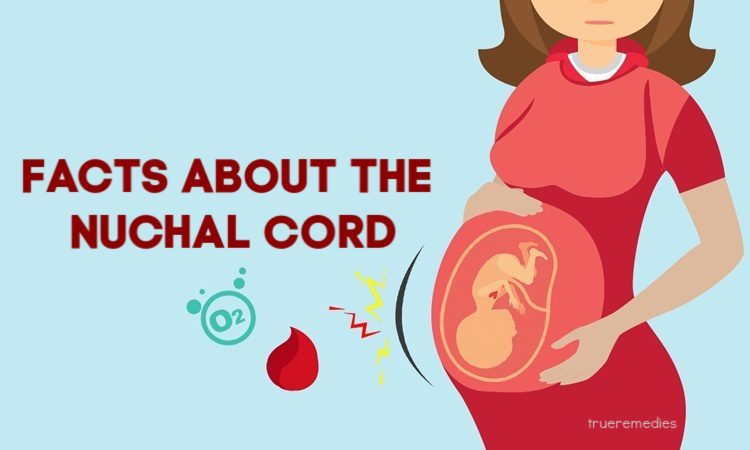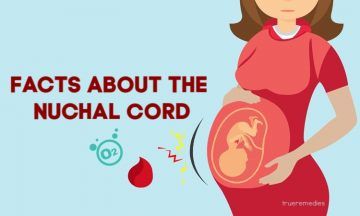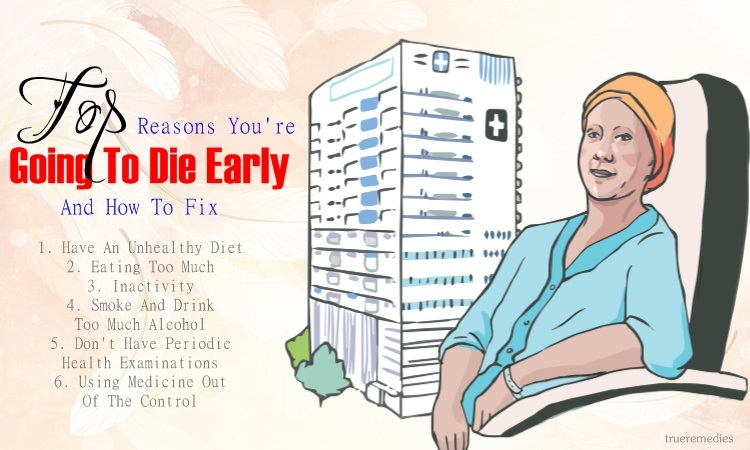Table Of Contents
An umbilical cord connects the placenta to the baby's abdomen, and its average length is about 21 inches[1]. The nuchal cord is defined to be the one that is wrapped or hangs around the baby's neck. Most of the mothers tend to be fear and worry a lot about this problem during the childbirth.
The nuchal cord is thought to cause difficulty and life-threatening issues during delivery, such as even a stillbirth. Doctors and experts claimed that a normal and healthy umbilical cord has many essential benefits for the unborn baby's life. It protects the baby from blood vessel compression and helps baby receive oxygen and nutrients.
It is a reason why, after the birth, the doctor will leave the umbilical cord uncut for at least two minutes until his or her head comes out and the baby can breathe through his or her nose.
So, what is the truth of nuchal cord? Is it dangerous, and does it need a doctor's intervention? Today, TrueRemedies will unveil ten exciting facts about nuchal cord around baby's neck. If you are interested in this topic, don't hesitate to read more.
- Causes Of Failure To Thrive In Babies And Toddlers
- Top 18 Pregnancy Do’s And Don’ts
- 21 Tips To Deal With Vomiting During Pregnancy
- Top 21 Foods To Avoid Feeding Babies In The First Year (This article was medically reviewed/fact checked by Dr Annie Markowitz)
Facts About The Nuchal Cord – What Moms May Not Know
I. What Causes Nuchal Cords
As we mentioned, the umbilical cord's length is so long that they can easily get tangled or wrapped around the fetus. If your unborn baby is active and causes a lot of random fetal movements, the chance of occurring a nuchal cord is higher. Furthermore, excess amniotic fluid is also another cause of nuchal cords as it induces more fetal movement in the womb.
II. Surprising Facts About Nuchal Cord Around Baby's Neck
1. One-Third Of Babies At Birth Have The Nuchal Cord
It is common for babies who are born to have the cord tangled and wrapped around their necks. However, many doctors do not talk with the moms about it as they can easily unwind or unloop the cord over the baby's head without problems.
TrueRemedies Partner Solutions

Need a Help from the Leading Expert Online, Available 24/7?
They’re all here and ready to answer your questions online or by phone. Keep asking questions until you get the answer you need.
If it isn't a dire or urgent emergency, doctors will leave this cord during birth to avoid any complications or compression.
According to studies, among three babies, one baby is likely to be born with a cord ranged from 19 to 133 centimetres long around their neck[2].
2. Three Ways To Classify Nuchal Cords
There are three ways for doctors to classify nuchal cords, which is one of the facts about the nuchal cord. The first one is to base on the number of times the cord around the unborn baby's neck: single nuchal cord or double nuchal cord, etc.
Secondly, it is based on whether the cord around the fetal neck is tight or loose. A loose nuchal cord can easily be unlooped over the baby's head during delivery while a tight one is defined as one that is difficult to remove and may cause compression on the fetal neck[3].
Thirdly, the nuchal cord is classified into Type A, and Type B. A Type A or unlocked nuchal cord is the one that can easily be unwound with the fetal movement because the umbilical end of the cord is under the placental end of the cord. On the other hand, the Type B or locked nuchal cord has the placental end under the umbilical end, which can lead to umbilical cord complications such as a “true knot”. A Type 2 nuchal cord can not be undone by fetal movement.
3. A Nuchal Cord Will Not Get Tighter During Delivery
According to a well-researched article of an Australian lecturer and researcher Doctor Rachel Reed, as labour progresses, cord and placenta will move down together and along with the baby when the uterus contracts.
The extra centimetres in length of this cord is required until the baby's head comes into the vagina. A nuchal cord is often thought of as a reason for “lack of progress” or “fetal distress” during the delivery. However, studies and researches have proved that there is no link between the nuchal cord and lack of progress or fetal distress.
During the labour, the baby's heart rate is dropping, but it is the normal behaviour because of the pressure around the head when the baby is pushing.
Therefore, the doctor doesn't have to interfere unless there is real fetal distress.
One thing you should remember is that giving birth in the wrong position and induction of delivery with medications such as synthetic oxytocin are possible causes of fetal distress.
4. A Nuchal Cord Doesn't Mean It Lead To Adverse Outcomes
This fact about the nuchal cord is hard to believe. Some mothers lost their babies, and their cords were around their neck.
However, because a nuchal cord incidence is familiar, you can also see that in babies born with complications. However, according to several studies, a cord that wraps around the fetal neck isn't the main culprit of adverse outcomes in babies[4].
Therefore, labour induction or any interference is unnecessary, and there is no need for moms to fear.
Adverse outcomes in babies or even loss and stillbirth can be caused by many other conditions, including unknown complications. Researchers and doctors themselves can not find out the exact causes of 100% cases. So, it is easy for moms and dads who suffer from the deep pain and sorrow blame the cord around their baby's neck.
Hopefully, we will soon discover these hidden causes overtime.
If parents are worried about their unborn baby, they should keep an eye on them and make a regular appointment with their doctor.
5. Even A Tight Nuchal Cord Doesn't Have An Increased Chance Of Cord Accidents
Not only a loose nuchal cord but also a tight one is common. A recent study claimed that a tight nuchal cord could be seen in 6.6% of over 200,000 born babies[5]. Although it is difficult to remove over the baby's head, there is no increased risk of stillbirth or life-threatening problems during labour. Many studies have shared the same findings.
6. Those With A Nuchal Cord Don't Need To Have A C-Section
The College Of Obstetricians and Gynaecologists in the United Kingdom stated that a nuchal cord is not a sign for a c-section (caesarean section)[6]. There is no proven link between the effectiveness of c-section and the presence of a nuchal cord in fetal.
Why do you need a c-section while the cord around the fetal neck doesn't indicate the high risk of childbirth problem? If you are worried about the cord complications, don't break the waters (rupture of the membranes). That has a higher risk than a cord around baby's neck as it may lead to cord compression.
7. Nuchal Cord Accidents Are Lower Than We Thought
The Australian Institute of Health and Welfare did a report which stated that only one out of 135 babies in Australia (0.74%) are born with stillbirth. In the United States, the number is one out of 160 births.
The Journal of the American Medical Association published a study, and it showed that placental issues such as placental abruption might increase the risk of stillbirth at 26%. A study in Sweden also had the same finding.
Furthermore, another possible cause (14-19%) of stillbirths is an infection.
Cord accidents have a tiny percent and not all of them are caused by a nuchal cord.
Cord abnormalities are thought to result from cord problems that include cord entrapment, fetal hypoxia, evidence of occlusion and prolapse.
A nuchal cord is not an indication of increased risk for death. The wrong thought of most parents is due to the difficulty in distinguishing between harmless cords around fetal necks and unhealthy cord conditions.
Some people may think that cords wrapped around baby's neck will cut off oxygen. However, that possibility is low. If this accident happens, the nuchal cord is not an underlying problem.
8. Multiple Nuchal Cord Are Not Harmful
A nuchal cord is also classified in the way based on how many loops around the fetal neck. However, unlike many people's thought, the number of loops does not decide the risk of stillbirth or any problems in babies during labour.
It is because, during delivery, the placenta, uterus, and cord move down together with the baby.
Furthermore, multiple loops are quite rare. The number of nuchal cord loops is from 1 to 4, but the incidence of two only affects between 2.5% to 8.3% of all births. 0.1% fetal has four or more loops. The maximum loops are reported to be 9.
9. Ultrasound Images From Multiple Angles Allow Physicians And Parents See A Nuchal Cord
A nuchal cord can be easily misdiagnosed as amniotic pockets, posterior cystic neck mass, fetal skin folds and even a cord near the baby's neck without encircling it. There are two ways of detecting nuchal cords: Color Doppler imaging and grey-scale ultrasounds[7] [8]. However, the first one is more accurate than the second.
10. Improper Management For Nuchal Cords Is Harmful To The Baby
Any improper management and intervention for nuchal cords will cause severe problems for babies. This one of exciting facts about the nuchal cord should be kept in mind. For example; cutting the cord before the baby's head comes out will disrupt the flow of oxygen to the baby. Other problems include hypoxic-ischemic encephalopathy (HIE), birth asphyxia, seizures, cerebral palsy, developmental and intellectual disabilities. In severe cases, it can lead to fetal death.
III. When To Need Doctor's Intervention
There is no increased risk for stillbirth, growth problems or lower Apgar scores related to a nuchal cord.
During the delivery, if the cord looped around the baby's neck is loose, the doctor will quickly make it slipped over his or her head. In the case of a tight loop, the midwife or doctor will find the right time to clamp and cut the nuchal cord without causing any problems until the rest of the baby's body moves downward.
Even when a tight nuchal cord does not mean your baby is at a high risk of stillbirth, your doctor will check it regularly during your pregnancy to make sure that everything is okay. If needed, he will offer a c-section.
If there is any chance of hypoxic-ischemic injury due to a tight nuchal cord around the fetal neck, doctors will suggest a treatment called a cooling therapy or known as therapeutic hypothermia to reduce brain damage.
Bear in mind that birth is a normal process. Worrying about anything won't put your mood at ease, and it does more harm than good for your pregnancy. Therefore, it is recommended asking your healthcare provider for reassurance if your baby has a nuchal cord.
In the days or weeks before your labour, take it easy and continue with your birth plan.
Have you given birth to a baby with a nuchal cord? Does your fetal have one? How did you feel and gain your calmness? Let's share with us in the comment section below. If you like our article about the exciting facts of the nuchal cord around baby’s neck, don’t forget to support our work.









